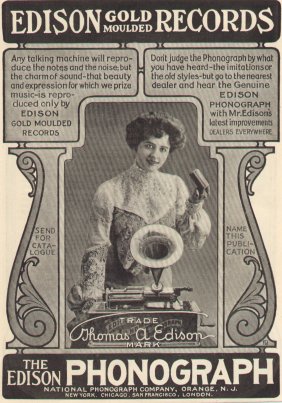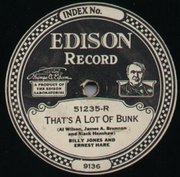Edison Records
|
|
Edison Records was the first record label, pioneering recorded sound and an important player in the early record industry.

| Contents |
Early phonographs before commercial mass produced records
Thomas A. Edison invented the phonograph, the first device for recording and playing back sound, in 1877.
After inventing and patenting the phonograph, Edison and his laboratory turned their attention to the commercial development of electric lighting, playing no further role in the development of the phonograph for a decade.
The earliest phonograph was something of a crude curiosity, although it was one that fascinated much of the public. Early machines were sold to entrepenuers who made a living out of traveling around the country giving "phonograph concerts" and demonstrating the device for a fee at fairs.
"Talking dolls" and "Talking clocks" were manufactured using the early phonograph; these were expensive novelties.
The start of the commercial record industry
In 1887 Edison Labs turned their attention back to improving the phonograph and the phonograph cylinder.
In 1888 the Edison company debuted the Perfected Phonograph, Edison produced wax cylinders 4 inches (10 cm) long, 2<pi> inches in diameter, playing some 2 minutes of music or entertainment, which became the industry standard.
Blank records were an important part of the business early on. Most phonographs had or could be fitted with attachments for the users to make their own recordings. One important early use was in business for recording dictation. Attachments were added to facilitate starting, stopping, and skipping back the recording for dictation and playback by stenographers. The business phonograph eventually evolved into a separate device from the home entertainment phonograph. Edison Record's brand of business phonograph was called The Ediphone; see dictaphone.
Mass produced cylinders
A notable technological triumph of the Edison Laboratories was devising a method to mass produce pre-recorded phonograph cylinders in molds. This was done by using very slightly tapered cylinders and molding in a material that contracted as it set. To Edison's disappointment the commercial potential of this process was not realized for some years. Most of the regional Edison distributors were able to fill the small early market for recordings by mechanical duplication of a few dozen cylinders at a time. Molded cylinders did not become a significant force in the marketplace until the end of the 1890s.
Mass producing cylinders at the Edison recording studio in New Jersey largely ended the local Edison retailers early practice of producing recordings in small numbers for regional markets, and helped concentrate the USA recording industry in the New York City - New Jersey area, already the headquarters of the nation's Tin Pan Alley printed music industry.
In 1902 Edison Records introduced Edison Gold Molded Records, cylinder records of improved hard black wax, capable of being played hundreds of times before wearing out.
In 1908 Edison introduced a new line of cylinders playing 4 rather than 2 minutes of music on the same sized record, achieved by shrinking the grooves and spacing them twice as close together. New machines were sold to play these records, as were attachments for modifying existing Edison phonographs. In October of 1912 the new Blue Amberol Records, made of an early type of plastic, were introduced for public sale. They were much more durable than wax cylinders.
In 1915 artists' names began to be added to the records; previously Edison had a policy of selling based on recognition of composers and pieces not performers.
Edison Records continued selling cylinders until they went out of business in 1929, but for the last decade these were simply dubs of their commercial disc records intended for customers who still used cylinder phonographs purchased years before.
Edison Records was eventually run by Thomas Edison's son Charles Edison.
EdisonRecordSleeveLivingArtist.jpg
Edison disc records
In October of 1913 the Edison Diamond Disc Record was introduced. Edison Laboratories had been experimenting with disc records for some 3 years, as the general public seemed to prefer them to cylinders. The thick Edison Discs recorded the sound vertically in the groove rather than laterally, and could only be played to their full advantage on Edison Diamond Disc Phonographs. This combination produced audio fidelity superior to any other home record playing system of the time. However Edison Discs and phonographs were more expensive than the competitors. This together with the uncompatability of the Edison system with other discs and machines had an adverse effect on Edison's market share. None the less, Edison Discs for a time became the third best selling brand in the United States, behind Victor and Columbia Records.
With World War I various materials used in Edison Discs came in short supply, and many discs pressed during the war were made in part with such make-shift materials as could be acquired at the time. This resulted in problems with surface noise even on new records, and Edison's market share shrank.
After the war Edison Records started a marketing campaign, hiring prominent singers and Vaudeville performers to perform along side and alternating with Edison records of their performances played on top-of-the-line "Laboratory Model" Edison Diamond Disc Phonographs. At various stages during the performances, all lights in the theater would be darkened and the audience challenged to guess if what they were hearing was live or recorded; accounts often said that much of the audience was astonished when the lights went back up to reveal only the Edison Phonograph on stage.
In 1928 the Edison company began plans for making "needle cut" records; by which they meant standard lateral cut discs like the "78s" marketed by almost every other company of the time. The Edison "Needle Cut" records debuted the following year. The audio fidelity was often comparable to the best of other record companies of the time, but they sold poorly as Edison's market share had declined to the point where it was no longer one of the leading companies and Edison had few distributors compared to leaders like Victor, Columbia, and Brunswick.
Edison Records closed down in 1929. The record plant and many of the employees were transferred to manufacturing radios. The masters for the Edison Records back catalogue were purchased by Henry Ford, and became part of the collection of the Henry Ford Museum. Some of the Edison catalogue is in the public domain and available for download at the following address at the Library of Congress website: http://memory.loc.gov/ammem/edhtml/eddcalpha.html
See also
External link
- The three surviving Edison cylinders (http://www.nps.gov/edis/cylinder_desc.htm) on the National Recording Registry with descriptions, audio and transcripts

